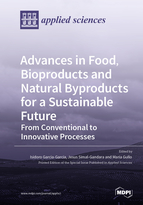Advances in Food, Bioproducts and Natural Byproducts for a Sustainable Future: From Conventional to Innovative Processes
A special issue of Applied Sciences (ISSN 2076-3417). This special issue belongs to the section "Food Science and Technology".
Deadline for manuscript submissions: closed (30 September 2021) | Viewed by 60651
Special Issue Editors
Interests: fermentation technology; food technology; acetic acid bacteria; vinegar
Interests: agro-environmental; food chemistry; sustainable primary production; food quality and safety
Special Issues, Collections and Topics in MDPI journals
Interests: foods and beverages fermentation; acetic acid bacteria; biopolymers; bacterial cellulose; valorization of agro-industrial wastes via fermentation
Special Issues, Collections and Topics in MDPI journals
Special Issue Information
Dear Colleagues,
The world population is expected to reach almost 10,000 million in 2050, which entails the need to focus on sustainability and its three pillars: economy, environment, and society. Within this context, it is necessary to use our resources efficiently; for instance, we will need to produce much food using less land and pollute less, to optimize the production of biomass from diversified resources, along with its subsequent conversion, fractionation, and processing. For this, new approaches and processes, with special emphasis from a biotechnological perspective, may need to be implemented to move towards a circular model that will confer environmental sustainability. Global projections of food losses constitute an abundant pool of complex carbohydrates, proteins, lipids, and functional compounds. Hence, the deployment of food waste streams as raw materials will encompass the formulation of added-value products that will be ideally reintroduced in the food supply chain to close the loop.
This Special Issue is devoted to the analysis and optimization of any food and bioproduct process as well as development of innovative and emerging food and byproducts processing methods, as a necessity for the sustainable transition to a bioeconomy era. Valorization, bioprocessing, and biorefining of food-industry-based streams, the role of industrial microorganisms, the isolation of high added-value compounds, applications of the resulting bio-based chemicals in food manufacturing, novel food formulations, economic policies for food waste management, along with sustainability or techno-economic assessment of processing methods constitute subject areas that need to be addressed. More specifically, bioprocess design to valorize food-industry waste and byproducts streams should be initiated by characterizing the composition of the onset raw material with the aim of identifying the target end-products, whereas the generation of multiple high added-value products is a prerequisite for cost-effective processes to establish economic sustainability. On top of that, the feasibility of innovative processes could be sustained by encompassing food applications, driven by the constantly emerging consumers’ demand for functional foods and beverages with enhanced nutritional value. Equally, a growing awareness for bio-based and natural food components is being developed, thereby imposing challenges on the substitution of chemically derived ingredients with their natural counterparts.
Prof. Dr. Isidoro Garcia-Garcia
Prof. Dr. Jesus Simal-Gandara
Dr. Maria Gullo
Guest Editors
Manuscript Submission Information
Manuscripts should be submitted online at www.mdpi.com by registering and logging in to this website. Once you are registered, click here to go to the submission form. Manuscripts can be submitted until the deadline. All submissions that pass pre-check are peer-reviewed. Accepted papers will be published continuously in the journal (as soon as accepted) and will be listed together on the special issue website. Research articles, review articles as well as short communications are invited. For planned papers, a title and short abstract (about 100 words) can be sent to the Editorial Office for announcement on this website.
Submitted manuscripts should not have been published previously, nor be under consideration for publication elsewhere (except conference proceedings papers). All manuscripts are thoroughly refereed through a single-blind peer-review process. A guide for authors and other relevant information for submission of manuscripts is available on the Instructions for Authors page. Applied Sciences is an international peer-reviewed open access semimonthly journal published by MDPI.
Please visit the Instructions for Authors page before submitting a manuscript. The Article Processing Charge (APC) for publication in this open access journal is 2400 CHF (Swiss Francs). Submitted papers should be well formatted and use good English. Authors may use MDPI's English editing service prior to publication or during author revisions.
Keywords
- food wastes and byproducts
- natural wastes and byproducts
- valorization strategies
- bioprocesses optimization
- bioactive compounds
- added-value products
- cosmetics
- nutraceuticals
- functional foods and beverages








